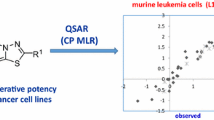Abstract
In the present work multiple linear regression analyses were performed to build QSAR models for nucleoside analogous using density functional theory (DFT) and molecular mechanics (MM+) based descriptors in both gas and solvent phases. The QSAR models for 14 carbocyclic analogues of nucleosides against murine leukemia cell line (L1210/0) and human T-lymphocyte cell lines (Molt4/C8 and CEM/0) explain more than 90% of the variances in the activity data along with higher values of \( r_{CV}^2\left( { > 0.86} \right) \). The energy of the next lowest unoccupied molecular orbital (ENL), electrophilicity (ω) and van der Waals surface area (SA) are the main independent factors contributing to the anticancer activity of nucleoside analogues. Inclusion of solvent medium increases the correlation of each descriptor with activity. Based on the key features responsible for anticancer activity, 10 new compounds with rather high anticancer activity have been theoretically designed. Cytotoxic activities of an additional set of 20 nucleoside analogues were also modeled by the same descriptors and found their predicted values to be in good agreement with the experimental values.



Similar content being viewed by others
References
Cheson BD, Keating MJ, Plunkett W (1997) Nucleoside analogs in cancer therapy. Dekker, New York
David YB, Jacques J, Lorraine LBH, France O, Sylvain BAR, Henriette G (2003) Cancer Chemother Pharmacol 52:497–506
Zbigniew P, Jean-Luc G, Cathey E, Guangyi W (2001) Nucleosides Nucleotides. Nucleic Acids 20:323–328
Fernandez F, Garcia-Mera X, Morales M, Rodriguez-Borges JE (2001) Synthesis 2:239–242
Abad F, Alvarez F, Fernandez F, Garcia-Mera X, Rodriguez-Borges JE (2001) Nucleosides Nucleotides. Nucleic Acids 20:1127–1128
Yao SW, Lopes VHC, Fernandez F, Garcia-Mera X, Morales M, Rodriguez-Borges JE, Cordeiroa MNDS (2003) Bioorg Med Chem 11:4999–5006
Wan J, Zhang L, Yang GF (2004) J Comput Chem 25:1827–1832
Srivastava HK, Pasha FA, Singh PP (2005) Int J Quantum Chem 103:237–245
Karelson M, Lobanov VS (1996) Chem Rev 96:1027–1043
Parr RG, Pearson RG (1983) J Am Chem Soc 105:7512–7516
Parr RG, Donnelly RA, Levy M, Palke WE (1978) J Chem Phys 68:3801–3807
Parr RG, Szentpaly LV, Liu S (1999) J Am Chem Soc 121:1922–1924
Parr RG, Yang W (1984) J Am Chem Soc 106:4049–4050
Chattaraj PK, Maiti B, Sarkar U (2003) J Phys Chem A 107:4973–4975
Chatterjee A, Balaji T, Matsunaga H, Mizukami F (2006) J Mol Graph Model 25:208–218
Roos G, Loverix S, De Proft F, Wyns L, Geerlings P (2003) J Phys Chem A 107:6828–6836
Parthasarathi R, Subramanian V, Roy DR, Chattaraj PK (2004) Bioorg Med Chem 12:5533–5543
Padmanabhan J, Parthasarathi R, Subramanian V, Chattaraj PK (2006) Bioorg Med Chem 14:1021–1028
Padmanabhan J, Parthasarathi R, Subramanian V, Chattaraj PK (2006) Chem Res Toxicol 19:356–364
Sarmah P, Deka RC (2008) Int J Quantum Chem 108:1400–1409
Sarmah P, Deka RC (2009) J Computer Aided Mol Design 23:343–354
Iczkowski RP, Margrave JL (1961) J Am Chem Soc 83:3547–3551
Koopmans TA (1933) Physica 1:104–113
Delley B (1990) J Chem Phys 92:508–517
Becke AD (1988) Phys Rev A 38:3098–3100
Lee C, Yang W, Parr RG (1988) Phys Rev 37:785–789
Hehre WJ, Radom L, Schlyer PR, Pople JA (1986) Ab Initio molecular orbital theory. Wiley, New York
Andzelm J, Koelmel C, Klamt A (1995) J Chem Phys 103:9312–9320
HyperChem; Release 7; Hypercube; http://www.hyper.com/, 2002
Wold S (1991) Quant Struct Act Rel 10:191–193
Fukui K, Yonezawa T, Shingu H (1952) J Chem. Phys 20:722–725
Fleming J (1976) Frontier orbital and organic chemical reaction. Wiley, New York
Helguera AM, Rodriguez-Borges JE, Garcia-Mera X, Fernandez F, Cordeiroa MNDS (2007) J Med Chem 50:1537–1545
Acknowledgments
The authors thank the Department of Science and Technology (DST), New Delhi for financial support.
Author information
Authors and Affiliations
Corresponding author
Rights and permissions
About this article
Cite this article
Sarmah, P., Deka, R.C. Anticancer activity of nucleoside analogues: A density functional theory based QSAR study. J Mol Model 16, 411–418 (2010). https://doi.org/10.1007/s00894-009-0551-9
Received:
Accepted:
Published:
Issue Date:
DOI: https://doi.org/10.1007/s00894-009-0551-9




